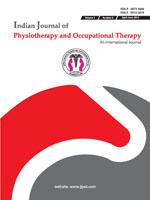Abstract Views: 1115 |
PDF Views: 0
Authors
Wishwas Kane Ketki
P.T School and Centre, Seth Dhurmal Bajaj Orthopaedic Centre, Seth G.S.Medical College and KEM hospital, Parel, Mumbai, India
Bhavana Suhas Mhatre
P.T School and Centre, Seth Dhurmal Bajaj Orthopaedic Centre, Seth G.S.Medical College and KEM hospital, Parel, Mumbai, India
Amita Mehta
P.T School and Centre, Seth Dhurmal Bajaj Orthopaedic Centre, Seth G.S.Medical College and KEM hospital, Parel, Mumbai, India
Abstract
Background: The iliotibial band is a long, non elastic collagen structure which crosses both hip and knee joints on the lateral thigh. The normal aging process brings changes in normal muscle functions including strength, endurance, agility and flexibility. Tight muscles further contribute to early degeneration of the joint. Routine physiotherapy includes hamstring, rectus femoris, and tendoachilis in the management of osteoarthritis. Thus, study aims to evaluate & compare effects of physical therapy intervention to improve the length of tight iliotibial band with respect to improvement in functional outcomes along with conventional physical therapy intervention.
Materials and Methods: 60 subjects having knee osteoarthritis with iliotibial muscle tightness participated in the study. They were divided into 2 groups: Group A and Group B, of 30 subjects each. Group A was given-iliotibial band stretching in Ober's test position and Conventional physical therapy (Ultrasound + Exercises). Group B was given- Conventional physical therapy only. Both the groups received the treatment for a period of 5 days.
Results: Results showed a statistically significant improvement on inter group comparison in the pain scores (on VAS) for walking, medial mobility of patella and Q angle. (p<0.001)
Conclusion: Conventional physical therapy is effective in improving pain and functional activities but Iliotibial band stretching has an added effect on functional activity of walking.
Keywords
Osteoarthritis, Ultrasound Stretching, Ober's Position



